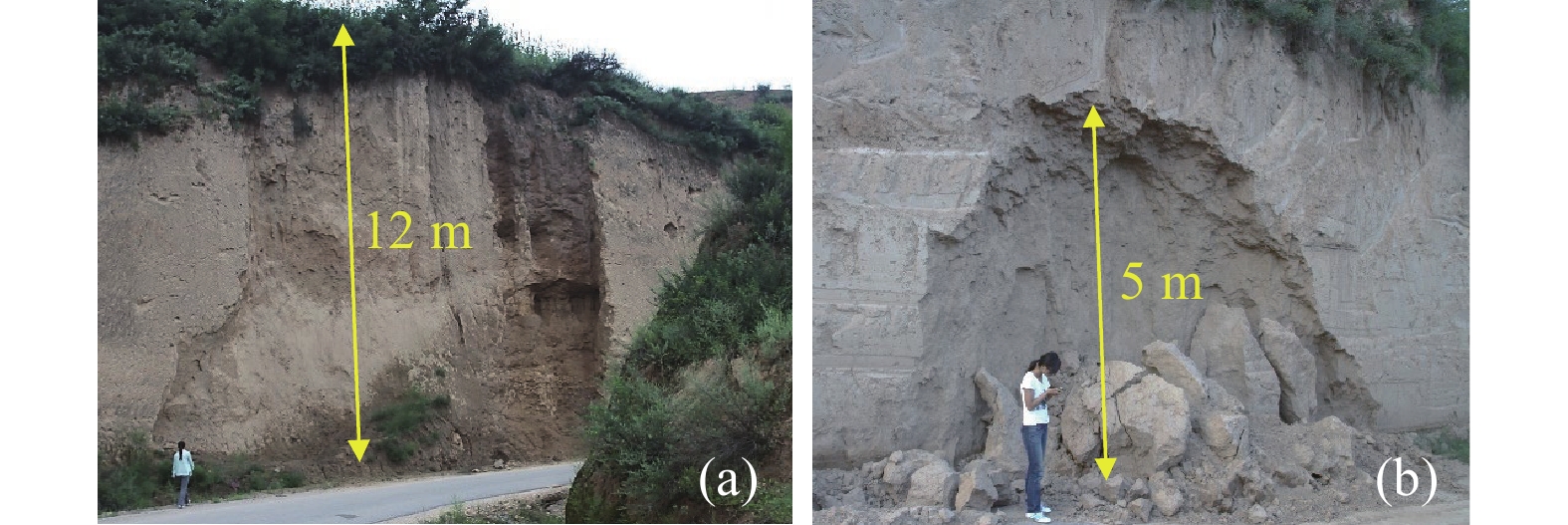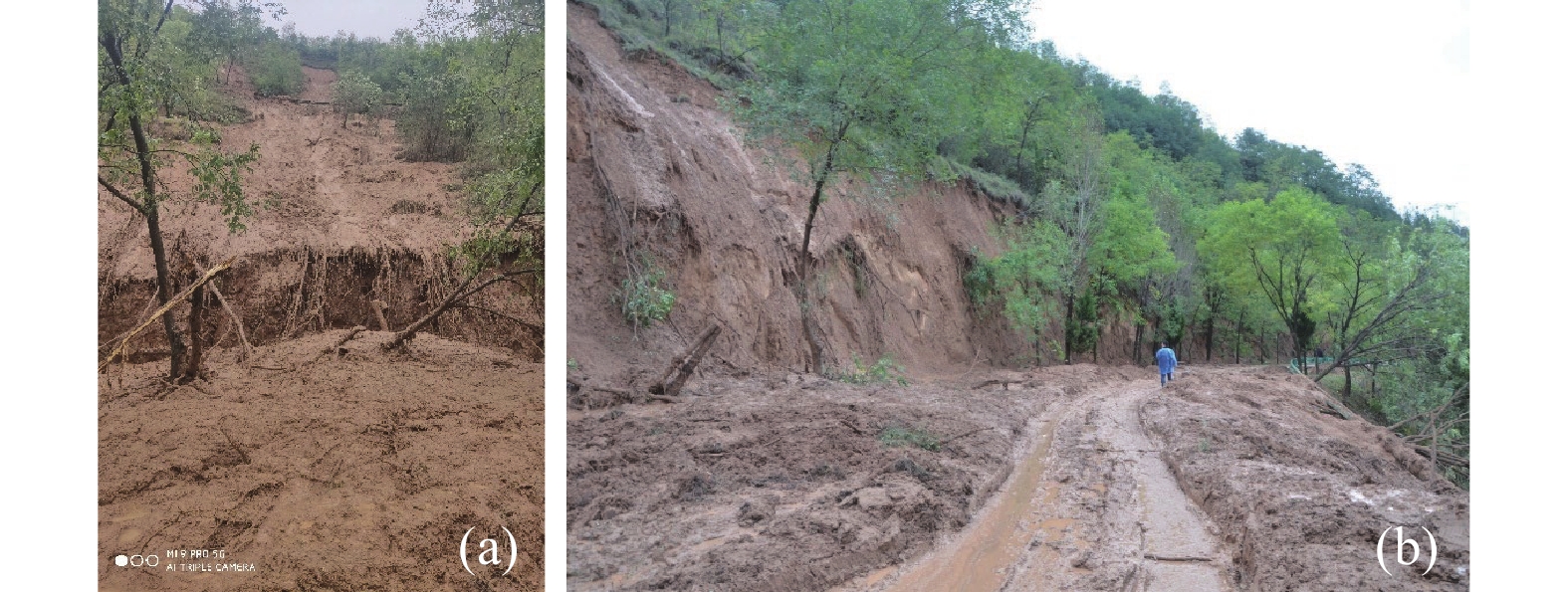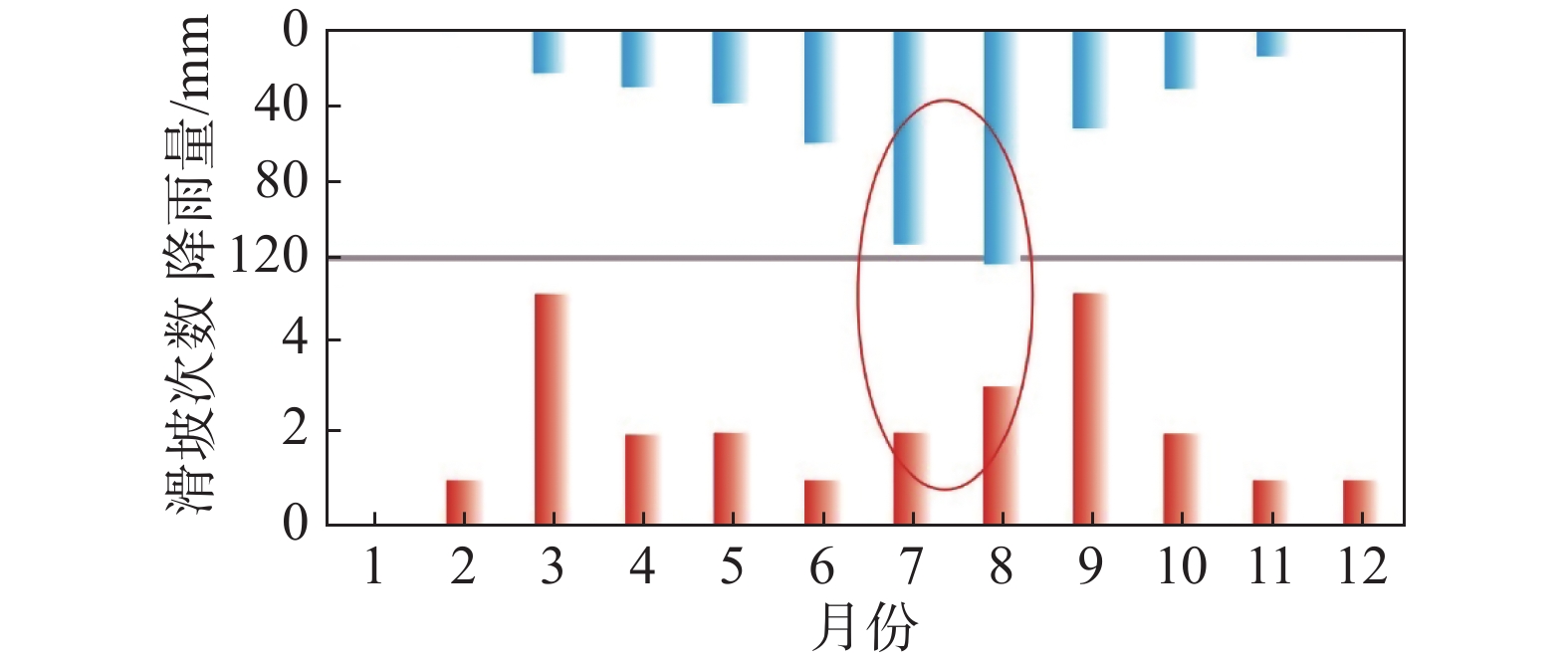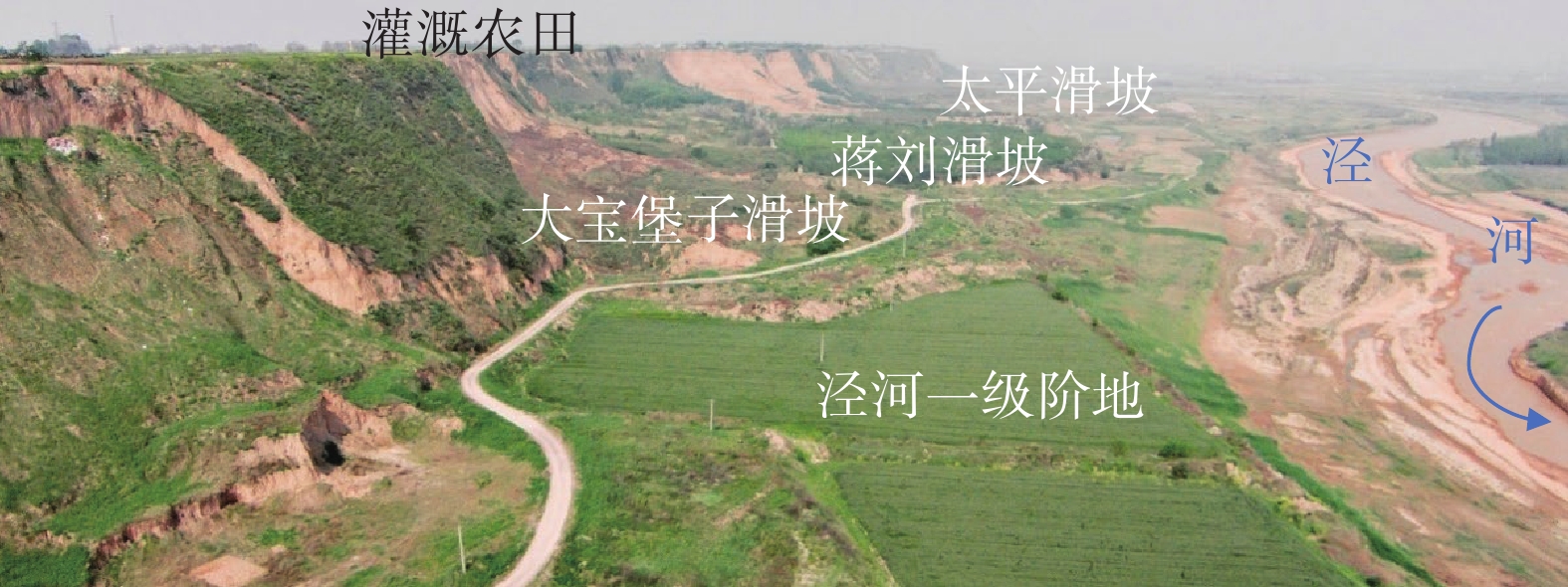Thoughts on modes of loess slope failure triggered by water infiltration and the principals for stability analysis
-
摘要: 水对斜坡作用包括地表水流动作用和地表水入渗作用,地表水流动作用,如水库、河流的岸坡破坏,由水动力侵蚀所引起。目前黄土中地表水入渗影响下的斜坡稳定性分析存在一些概念含糊的问题,如忽略了入渗过程的应力路径,只考虑其破坏时的应力状态,这会导致对其破机理和稳定性计算参数取值的误判,文章只针对该类问题进行辨析讨论。黄土中地表水的入渗一般有降雨和灌溉两种,伴随降雨入渗多引起斜坡浅层破坏;灌溉导致地下水位上升则引起深层滑移。地表水入渗对斜坡总应力改变不大,水致斜坡破坏主要是孔隙水压力上升,土体有效应力降低所致。非饱和黄土中的初始孔隙水压力为负值,降雨入渗后的浅层黄土仍处于非饱和状态,孔压最大升到0;灌溉会引起地下水位抬升,潜水位下为正的孔隙水压力。明确了孔压变化过程,就可以用有效强度评价边坡稳定性。同时,目前一些观点认为关于流动性黄土滑坡是静态引起,这颠倒了因果关系,是滑移引起了液化,而不是液化导致的滑移。Abstract: The action on water slope includes surface water flow and surface water infiltration, and surface water flow, such as slope damage of reservoir and river banks, is caused by hydrodynamic erosion. At present, there are some vague concepts in slope stability analysis under the influence of surface water infiltration in loess. For example, ignoring the stress path in the infiltration process and only considering the stress state at the time of its failure will lead to misjudgment of its failure mechanism and the value of stability calculation parameters. This paper aims to analyses and clarify the issues. There are two sources of groundwater in loess, those are rainfall and irrigation. Rainfall infiltration produces shallow slope failure during raining time, while irrigation causes groundwater level rising to trigger deep seated slide. Surface water infiltration can make a remarkable rising of pore water pressure, but minor change of the total stress, and a consequent decreasing of effective stress in the slope, which is the cause of slope failure triggered by water. The initial pore water pressure in unsaturated loess is negative, and the shallow loess after rainfall infiltration is still in unsaturated state, and the pore water pressure rises to 0 at the maximum. Irrigation will cause the groundwater level to rise, and the pore water pressure under the water table will be positive. When the change process of pore water pressure is made clear, the slope stability can be evaluated by effective strength. At the same time, at present, some opinions think that the landslide of flowing loess is caused by static state, which reverses the causality, and it is the slip that causes liquefaction, not the slip caused by liquefaction.
-
Keywords:
- loess slope /
- shallow failure /
- deep seated slide /
- rainfall /
- irrigation
-
2010年8月8日凌晨,舟曲县城北侧三眼峪沟和罗家峪沟同时暴发特大山洪泥石流,城区三分之一被淹,共造成1435人死亡,330人失踪,直接经济损失超过10亿元[1-2],给舟曲县城居民生命财产造成了巨大损失,也给当地生产生活带来严重困难。灾害引起了党中央、国务院、中央军委及全国人民的高度关注,启动国家二级救灾应急响应,同时批复专项资金进行治理。其中,重力式拦挡坝是舟曲泥石流治理中的最主要工程之一。
周龙茂等[3]认为拦挡坝在泥石流治理中发挥着重要作用,但同时拦挡坝也是最易遭受破坏、失去防灾功能的泥石流防治构筑物,因此,在泥石流设计中,为了拦挡坝不被破坏,往往设计得很保守,王念秦等[4]提出这种设计容易造成两个极端现象:保守,造成资金浪费;冒进,防治工程失败。要做到既能保证拦挡坝安全,又能将投资最小化,就要求对泥石流拦挡坝抗冲击力验算方法提出新要求。传统的泥石流冲击力计算经验公式[5]只能通过大量试算表述结果,不能表述过程。而将三维有限元数值分析方法应用到泥石流拦挡坝稳定性验算中[6-7],能将过程和结果同时呈现,即通过分步加载的方法,逐步呈现拦挡坝的位移情况和抗冲击力过程中的破损情况。
关于拦挡坝的数值模拟研究还比较少,本文将考虑损伤的混凝土本构模型与有限元计算方法相结合,对舟曲泥石流混凝土拦挡结构进行力学分析,最终确定了拦挡坝的抗冲击力合理区间,以期为泥石流治理工程的设计提供借鉴。
1. 模型建立及相关参数的设定
杨东旭等[8]、许海亮等[9]、张睿骁等[10]认为冲击力是破坏防治工程构筑物的主要作用力之一,其大小与泥石流流量、流速、容重等有关。泥石流冲击力是泥石流防治工程设计的重要参数,分为流体整体冲击力和个别石块的冲击力两种,在设计中取两种计算结果较高者为设计依据。文章采用《泥石流灾害防治工程设计规范》(DZT 0239—2004)中的经验公式[5]作为数值计算结果的参考和验证。
流体整体冲击力计算公式:
$$f = K\frac{{{\gamma_C}}}{g}v_c^2$$ (1) 式(1)中:f−冲击力/Pa;
K−系数,取2.5;
${\gamma_C} $ −泥石流重度/(t·m−3);g−重力加速度,取9.8 m·s−2;
vc−断面处泥石流流速(m·s−1)。
个别石块的冲击力计算公式:
$${F_b} = \sqrt {\frac{{48EJ{V^2}W}}{{g{L^3}}}} \cdot \sin \alpha $$ (2) 式(2)中:Fb−泥石流大石块冲击力/(t·m−2);
E−工程构件弹性模量/(t·m−2);
J−工程构件界面中心轴的惯性矩/m4;
V−石块运动速度(m·s−1);
W−石块重量/t;
L−构件长度/m;
α−石块运动方向与构件受力面的夹角/(°)。
泥石流具体参数和计算结果见表1,编号和《甘肃省舟曲县三眼峪沟泥石流灾害设计报告》[1]中保持一致。
表 1 泥石流冲击力计算参数及结果Table 1. Debris flow impact calculation parameters and results编号 ${\gamma _c}$/(t·m−3) ${v_c}$/(m·s−1) $L$/m $W$/t $V$/(m·s−1) $\sin \alpha $ $E$/(t·m−2) $J$/m4 $f$/(t·m−2) ${F_b}$/(t·m−2) 大1号坝 2.09 6.56 5.5 162 10.55 0.946 2.8 274.63 22.49 7.14 大2号坝 2.09 6.60 2.8 81 7.53 0.946 2.8 274.63 22.76 7.34 大3号坝 2.03 6.61 8.6 259.2 13.20 0.946 2.8 216.00 22.17 19.95 大4号坝 2.03 8.67 4.3 94.5 9.33 0.946 2.8 421.88 38.15 19.62 小2号坝 2.03 6.56 3.1 83.7 7.92 0.946 2.8 421.88 21.84 4.28 小3号坝 2.13 9.86 5.8 129.6 10.84 0.946 2.8 274.63 51.77 8.98 小4号坝 2.13 5.49 2.8 75.6 7.53 0.946 2.8 421.88 16.05 14.17 小6号坝 2.13 8.12 4.7 121.5 9.76 1.000 2.8 512.00 35.11 37.01 主1号坝 2.13 6.53 11.2 361.8 15.06 0.946 2.8 421.88 22.71 44.35 主2号坝 2.13 6.16 7.5 234.9 12.32 0.946 2.8 343.00 20.21 12.44 计算区域按地质资料分高程、分区域模拟。模型向上游及下游分别延伸至坝体厚度的2倍,模型高度方向自坝基向下延伸坝体垂直部分的2倍。以大2号坝为例进行数值模拟,砼坝体和地基土数值分析具体参数见表2。
分析中将泥石流流体的冲击力P简化为静力加载到坝体侧面,计算坝体的极限抗冲击能力,简化计算力学模型如图1所示。
表 2 混凝土坝和地基碎石土参数Table 2. Concrete dam and gravel soil parameter名称 坝体 沟床碎石土 弹性模量/GPa 泊松比 损伤阈值 拉压强度比 弹性模量/MPa 泊松比 黏聚力/kPa 内摩擦角/(°) 剪胀角/(°) 取值 24.0 0.2 2×10−4 0.15 240 0.2 5.0 40 40 2. 重力式拦挡坝抗冲击力数值分析
数值模拟使用有限元软件ABAQUS进行计算分析。冯帅等[11]认为数值计算出的泥石流的极限抗冲压力大于经验公式计算出的泥石流整体冲击压力。因此,本文分别按泥石流流体高度h=H/2坝高(工况1)及h=H(工况2)两种工况进行分析,将数值计算出的抗冲击力限定在一合理区间。计算中加载每一荷载增量后均计算至收敛,并记录坝体的最大位移。加载至破坏时(计算不收敛,坝体位移不断增大)的压力P与坝体最大位移曲线由倾斜直线变为水平线,坝体所能承受的最大冲击力Pu可由压力P与坝体最大位移曲线水平段的和坐标求出。应力以拉为正,以压为负,应力的单位为Pa,长度单位为m,位移单位为mm,其他单位均采用国际单位制。具体模型边界和网格划分图2所示。
2.1 工况1条件下重力式拦挡坝抗冲击力数值分析
大坝按泥石流冲击高度h=H/2坝高计算,在拦挡坝的一侧施加泥石流冲击力,荷载增量取值100 kPa,每加一次荷载,计算至收敛,并且记录一次坝体的最大位移;一直持续加载至破坏时,即计算不收敛且坝体位移不断增大时停止计算。
周勇等[12]采用结构动力学的方法,建立了泥石流冲击荷载与拦挡坝的动力方程,提出拦挡坝的坝顶处有最大的位移,为本次工程力学计算提供了一种思路。将泥石流冲击力与相应荷载下坝体位移进行统计,形成图3所示冲击力与坝体最大位移关系曲线,会发现坝体水平位移随着拦挡坝冲击力增大呈对数曲线递增,泥石流流体高度h=H/2工况条件下施加的最大冲击力Pu=3500 kPa(357.14 t/m2)。
坝体损毁过程如图4所示,冲击力达到800 kPa(水平位移1 mm)时坝体开始出现初始损伤;冲击力达到1100 kPa(水平位移1.4 mm)时两侧坝肩和基础局部都出现较明显损伤;冲击力达到1400 kPa时(水平位移2 mm),泄水孔和泄水涵洞边缘出现局部损伤;冲击力达到2700 kPa(水平位移4.8 mm)时,基础出现大面积损伤,沿正面泄水涵洞和泄水孔形成纵向损伤;冲击力达到3200 kPa(水平位移7.2 mm)时,坝肩、基础及坝体正中损伤贯通,损伤区呈“W”型,坝体已基本失去功能,在工程实际应用中已达到破坏极限;冲击力达到3500 kPa时,坝体大面积损伤,超过坝体总面积的2/3,水平位移高达14 mm,整体性降低或消失,这只是一种模拟现象,在工程实际应用中泥石流物质沿坝体破坏处流通,坝体已不存在整体位移现象。
2.2 工况2条件下重力式拦挡坝极限抗冲压数值分析
大坝按泥石流冲击高度h=H坝高计算,荷载增量取值125 kPa,每加一次荷载,计算至收敛,同时记录一次坝体的最大位移,将泥石流冲击力与相应荷载下坝体位移进行统计,形成图5所示冲击力与坝体最大位移关系曲线,会发现坝体水平位移随着拦挡坝冲击力增大也呈对数曲线递增,泥石流流体高度h=H工况条件下施加的最大冲击力Pu=2490 kPa(254.08 t/m2)。
坝体损毁过程如图6所示,冲击力达到375 kPa(水平位移1.7 mm)时坝体开始出现初始损伤;冲击力达到500 kPa(水平位移2.3 mm)时两侧坝肩和基础局部都出现较明显损伤;冲击力达到1250 kPa(水平位移6.6 mm)时,泄水孔和泄水涵洞边缘出现局部损伤;冲击力达到1500 kPa(水平位移8.4 mm)时,基础出现局部损伤,沿正面泄水涵洞和泄水孔形成纵向损伤,两侧坝肩损伤较严重;冲击力达到2000 kPa(水平位移14.8 mm)时,严重损伤区呈“W”型,坝肩、基础和坝体中心部位损伤基本贯通,坝体已基本失去功能,在工程实际应用中已达到破坏极限;冲击力达到2490 kPa时,坝体大面积损伤,超过坝体总量的2/3,水平位移高达40.4 mm,整体性降低或消失,这也只是一种模拟现象,在工程实际应用中泥石流物质沿坝体破坏处流通,坝体已不存在整体位移。
3. 坝体冲击力安全验算
同样方法计算三眼峪及各支沟泥石流重力式拦挡工程冲击力,得到表3,结合表1可以看出,泥石流经验公式计算的单宽冲击力均小于工况1数值模拟验算结果,均大于工况2数值模拟验算结果,与工况1和2的平均值接近。2012年建成至今,大部分坝体库容淤积过半,部分甚至已淤满,说明拦挡坝经受住了各种泥石流冲击破坏的考验。
表 3 重力坝冲击力数值模拟验算结果对比表(单位:t/m2)Table 3. Comparison of results of numerical simulation of impact of gravity dam (unit: t/m2)编号 经验公式
计算冲击力h=H/2
最大冲击力h=H
最大冲击力计算平均值 大1号坝 22.49 27.00 17.55 22.28 大2号坝 22.76 27.36 17.78 22.57 大3号坝 22.17 26.64 17.32 21.98 大4号坝 38.15 45.84 29.80 37.82 小2号坝 21.84 26.28 17.08 21.68 小3号坝 51.77 62.16 40.40 51.28 小4号坝 16.05 19.32 12.56 15.94 小6号坝 37.01 44.52 28.94 36.73 主1号坝 44.35 53.28 34.63 43.96 主2号坝 20.21 24.36 15.83 20.10 4. 讨论
4.1 泥石流冲击高度对坝体影响
将2种工况进行比较,工况1的冲击力达到800 kPa时坝体开始出现初始损伤,最大冲击力为3500 kPa,而工况2的冲击力达到375 kPa时桩体开始出现初始损伤,最大冲击力为2490 kPa。说明冲击高度对坝体的影响较大,随高度增加,达到初损的冲击力荷载几乎成倍数减少,而最大冲击力也减少1000 kPa。这说明在拦挡坝设计中泄水涵洞和泄水孔的预留很重要,为减少拦挡坝的冲击破坏,应尽量选择低坝,同时在不影响坝体安全和停淤功能的基础上,应多布设泄水涵洞和泄水孔,降低坝前壅水位,最大可能避免或减少高水位过流。
4.2 拦挡坝损伤过程对拦挡坝设计的指导意义
拦挡坝的损伤从两侧坝肩开始,再到拦挡坝中间部位的泄水涵洞及泄水孔边缘,然后到基础,最后坝肩、中间部位和基础形成“W”型的贯通破坏,其破损部位按先后顺序依次为“坝肩—泄水涵洞及泄水孔—基础—“W”型贯通”4个过程。设计时应重点考虑这几处薄弱环节,要相应的进行专门的加固处理。
4.3 拦挡坝冲击力设计的合理范围
从安全和经济方面考虑,在拦挡坝设计中冲击力的考虑应该取工况1和工况2之间值较合理,工况1存在风险,工况2偏保守,而工况1和2的中间值接近经验公式计算冲击力。从表3中可知,三眼峪设计中的冲击力选择也是工况1和2的平均值,从而保障了拦挡坝的安全运行。
4.4 可作为现有泥石流设计理论的有效补充
由于真实模拟泥石流重力式拦挡坝的室内大型实验难度比较大,野外测定随机性太大,故本文采用数值模拟的方式来分析三眼峪沟拦挡坝的受力情况。结果表明数值模拟对分析问题有一定的指导意义,可以和现有的泥石流设计理论结合,为以后工程设计提供安全对比,但是不能代替物理实验和理论计算。
5. 结论
(1)本文通过有限元软件ABAQUS进行拦挡坝数值模拟计算和分析,比较2种工况条件发现:随着泥石流冲击高度增加,达到初损的冲击力荷载成倍数减少,而最大冲击力也减少1000 kPa;拦挡坝的损伤从两侧坝肩开始,再到拦挡坝中间部位的泄水涵洞及泄水孔边缘,形成“W”型的贯通破坏。
(2)通过与经验公式计算冲击力比较,发现拦挡坝设计中冲击力选择工况1和2的平均值较合理,可以为工程设计提供安全对比。
-
-
[1] 张茂省, 李同录. 黄土滑坡诱发因素及其形成机理研究[J]. 工程地质学报,2011,19(4):530 − 540. [ZHANG Maosheng, LI Tonglu. Triggering factors and forming mechanism of loess landslides[J]. Journal of Engineering Geology,2011,19(4):530 − 540. (in Chinese with English abstract) DOI: 10.3969/j.issn.1004-9665.2011.04.014 [2] WANG G L, LI T L, XING X L, et al. Research on loess flow-slides induced by rainfall in July 2013 in Yan’an, NW China[J]. Environmental Earth Sciences,2015,73(12):7933 − 7944. DOI: 10.1007/s12665-014-3951-9
[3] 习羽, 李同录, 邢鲜丽. 灌渠渗漏诱发的黄土滑坡泥流触发机理分析[J]. 地球科学与环境学报,2017,39(1):135 − 142. [XI Yu, LI Tonglu, XING Xianli. Analysis of the triggering mechanism of a loess flowslide induced by water canal leakage[J]. Journal of Earth Sciences and Environment,2017,39(1):135 − 142. (in Chinese with English abstract) DOI: 10.3969/j.issn.1672-6561.2017.01.011 [4] TU X B, KWONG A K L, DAI F C, et al. Field monitoring of rainfall infiltration in a loess slope and analysis of failure mechanism of rainfall-induced landslides[J]. Engineering Geology, 2009, 105(1/2): 134-150.
[5] XU L, DAI F C, THAM L G, et al. Field testing of irrigation effects on the stability of a cliff edge in loess, North-west China[J]. Engineering Geology,2011,120(1/2/3/4):10 − 17.
[6] 邢鲜丽, 李同录, 李萍, 等. 黄土抗剪强度与含水率的变化规律[J]. 水文地质工程地质,2014,41(3):53 − 59. [XING Xianli, LI Tonglu, LI Ping, et al. Variation regularities of loess shear strength with the moisture content[J]. Hydrogeology & Engineering Geology,2014,41(3):53 − 59. (in Chinese with English abstract) [7] 李同录, 习羽, 侯晓坤. 水致黄土深层滑坡灾变机理[J]. 工程地质学报, 2018, 26(5): 1113-1120 LI Tonglu, XI Yu, HOU Xiaokun. Mechanism of surface water infiltration induced deep loess landslide[J]. Journal of Engineering Geology, 2018, 26(5): 1113-1120. (in Chinese with English abstract)]
[8] 李萍, 李同录, 侯晓坤, 等. 黄土中毛细上升速率的现场测试[J]. 河海大学学报(自然科学版), 2014, 42(6): 503-507 LI Ping, LI Tonglu, HOU Xiaokun, et al. Field experiment on rate of capillary rise in loess[J]. Journal of Hohai University (Natural Sciences), 2014, 42(6): 503-507. (in Chinese with English abstract)]
[9] 李宝平, 杨倩, 张玉, 平高权, 等. 初始固结应力对平面应变黄土剪切破坏特性影响[J]. 水文地质工程地质,2020,47(5):92 − 99. [ LI Baoping, YANG Qian, ZHANG Yu, PING Gaoquan, et al. Effect of initial solidification stress on shear failure characteristics of loess under the plane strain condition[J]. Hydrogeology & Engineering Geology,2020,47(5):92 − 99. (in Chinese with English abstract) [10] 强菲, 李萍, 李同录. 黄土完全软化强度与残余强度的对比试验研究[J]. 工程地质学报,2014,22(5):832 − 838. [QIANG Fei, LI Ping, LI Tonglu. Comparative test study between fully softened and residual strengths of loess[J]. Journal of Engineering Geology,2014,22(5):832 − 838. (in Chinese with English abstract) [11] VANAPALLI S K, FREDLUND D G, PUFAHL D E, et al. Model for the prediction of shear strength with respect to soil suction[J]. Canadian Geotechnical Journal,1996,33(3):379 − 392. DOI: 10.1139/t96-060
[12] 吴宏伟. 大气–植被–土体相互作用: 理论与机理[J]. 岩土工程学报,2017,39(1):1 − 47. [WU Hongwei. Atmosphere-plant-soil interactions: Theories and mechanisms[J]. Chinese Journal of Geotechnical Engineering,2017,39(1):1 − 47. (in Chinese with English abstract) [13] 徐则民, 黄润秋, 唐正光, 等. 植被护坡的局限性及其对深层滑坡孕育的贡献[J]. 岩石力学与工程学报,2005,24(3):438 − 450. [XU Zemin, HUANG Runqiu, TANG Zhengguang, et al. Limitations of biotechnical slope protection and contribution of vegetation to deep seated landslide preparation[J]. Chinese Journal of Rock Mechanics and Engineering,2005,24(3):438 − 450. (in Chinese with English abstract) [14] 孙长忠, 黄宝龙, 陈海滨, 等. 黄土高原人工植被与其水分环境相互作用关系研究[J]. 北京林业大学学报,1998,20(3):10 − 17. [SUN Changzhong, HUANG Baolong, CHEN Haibin, et al. Study on the interaction between artificial vegetation and its water environment in the Loess Plateau[J]. Journal of Beijing Forestry University,1998,20(3):10 − 17. (in Chinese with English abstract) [15] 韩勇, 郑粉莉, 徐锡蒙, 等. 子午岭林区浅层滑坡侵蚀与植被的关系—以富县“7·21”特大暴雨为例[J]. 生态学报,2016,36(15):4635 − 4643. [HAN Yong, ZHENG Fenli, XU Ximeng, et al. Relationship between shallow landslide erosion and vegetation in the Ziwuling forest area: A case study of the "7·21" disaster in Fuxian County[J]. Acta Ecologica Sinica,2016,36(15):4635 − 4643. (in Chinese with English abstract) [16] 许领, 戴福初, 闵弘, 等. 泾阳南塬黄土滑坡类型与发育特征[J]. 地球科学(中国地质大学学报),2010,35(1):155 − 160. [XU Ling, DAI Fuchu, MIN Hong, et al. Loess landslide types and topographic features at south Jingyang plateau, China[J]. Earth Science-Journal of China University of Geosciences,2010,35(1):155 − 160. (in Chinese with English abstract) DOI: 10.3799/dqkx.2010.016 [17] 程秀娟, 张茂省, 朱立峰, 等. 季节性冻融作用及其对斜坡土体强度的影响-以甘肃永靖黑方台地区为例[J]. 地质通报,2013,32(6):904 − 909. [CHENG Xiujuan, ZHANG Maosheng, ZHU Lifeng, et al. Seasonal freeze-thaw action and its effect on the slope soil strengthin Heifangtai area Gansu Province[J]. Geological Bulletin of China,2013,32(6):904 − 909. (in Chinese with English abstract) DOI: 10.3969/j.issn.1671-2552.2013.06.013 [18] 亓星, 许强, 李斌, 等. 甘肃黑方台黄土滑坡地表水入渗机制初步研究[J]. 工程地质学报,2016,24(3):418 − 424. [QI Xing, XU Qiang, LI Bin, et al. Preliminary study on mechanism of surface water infiltration at Heifangtai loess landslides in Gansu[J]. Journal of Engineering Geology,2016,24(3):418 − 424. (in Chinese with English abstract) [19] 金艳丽, 戴福初. 地下水位上升下黄土斜坡稳定性分析[J]. 工程地质学报,2007,15(5):599 − 606. [JIN Yanli, DAI Fuchu. Analysis of loess slope stability due to groundwater rise[J]. Journal of Engineering Geology,2007,15(5):599 − 606. (in Chinese with English abstract) DOI: 10.3969/j.issn.1004-9665.2007.05.004 [20] 张常亮, 李萍, 李同录, 等. 黄土中降雨入渗规律的现场监测研究[J]. 水利学报,2014,45(6):728 − 734. [ZHANG Changliang, LI Ping, LI Tonglu, et al. In-situ observation on rainfall infiltration in loess[J]. Journal of Hydraulic Engineering,2014,45(6):728 − 734. (in Chinese with English abstract) [21] ZHANG C l, LI T L, LI P. Rainfall infiltration in Chinese loess by in situ observation[J]. Journal of Hydrologic Engineering, 2014, 19(9): 06014002.
[22] 李萍, 李同录, 付昱凯, 等. 非饱和黄土中降雨入渗规律的现场监测研究[J]. 中南大学学报(自然科学版),2014,45(10):3551 − 3560. [LI Ping, LI Tonglu, FU Yukai, et al. In-situ observation on regularities of rainfall infiltration in loess[J]. Journal of Central South University (Science and Technology),2014,45(10):3551 − 3560. (in Chinese with English abstract) [23] ZHANG Y G, LI T L, SHEN W, et al. Hydraulic model of transition of transient to steady flows in the vadose zone[J]. Journal of Hydrologic Engineering,2019,24(12):04019052. DOI: 10.1061/(ASCE)HE.1943-5584.0001843
[24] 金艳丽, 戴福初. 饱和黄土的静态液化特性试验研究[J]. 岩土力学,2008,29(12):3293 − 3298. [JIN Yanli, DAI Fuchu. Experimental investigation of static liquefaction of saturated loess[J]. Rock and Soil Mechanics,2008,29(12):3293 − 3298. (in Chinese with English abstract) DOI: 10.3969/j.issn.1000-7598.2008.12.021 [25] 张一希, 许强, 刘方洲, 等. 不同地区饱和原状黄土静态液化特性试验研究[J]. 地质科技情报,2018,37(5):229 − 233. [ZHANG Yixi, XU Qiang, LIU Fangzhou, et al. Experimental investigation of static liquefaction of undisturbed saturated loess in different regions[J]. Geological Science and Technology Information,2018,37(5):229 − 233. (in Chinese with English abstract) [26] SASSA K. Geotechnical model for the motion of slides[C]. Proceedings of 5th International Symposium on landslides, 1988, I: 37 − 56.
-
期刊类型引用(26)
1. 李超然,袁广祥. 甘肃省宕昌县地质灾害易发性评价. 地质灾害与环境保护. 2025(01): 21-25 .  百度学术
百度学术
2. 兰盈盈,郭昶成,朱云福. 地质灾害易发性评价方法综述. 地质与资源. 2024(01): 65-73 .  百度学术
百度学术
3. 杨晶晶,肖玉,安泉,刘浩,公斌. 黔东北地区地质灾害时空分布规律及孕灾地质环境研究. 中国煤炭地质. 2024(02): 64-68 .  百度学术
百度学术
4. 李晓玮,刘翠娜. 基于AHP法山区公路边坡稳定性评价及危害性分析. 河北地质大学学报. 2024(02): 61-65+134 .  百度学术
百度学术
5. 南赟,翟淑花,李岩,曹颖,罗守敬,王云涛,郭学飞. 北京地区“23·7”特大暴雨型地质灾害特征及预警成效分析. 中国地质灾害与防治学报. 2024(02): 66-73 .  本站查看
本站查看
6. 曾欣,黄梦妮,胡毓灵,邓新林,谢倩雯. 株洲市地质灾害特征与降雨量的关系. 气象研究与应用. 2024(01): 83-89 .  百度学术
百度学术
7. 唐朝. 基于ArcGIS的当涂县地质灾害风险调查与评价. 现代矿业. 2024(04): 187-190+196 .  百度学术
百度学术
8. 蔡佳明. 北京东部山区地质灾害危险性评价. 地质灾害与环境保护. 2024(02): 49-55 .  百度学术
百度学术
9. 李晓玮. 北京北宫镇大灰厂路牵引式岩质滑坡勘查及防治对策. 城市地质. 2024(02): 139-148 .  百度学术
百度学术
10. 赵丹凝,焦润成,杨春. “23·7”强降雨对北京西山曹家坊泥石流隐患易发性影响. 城市地质. 2024(03): 353-364 .  百度学术
百度学术
11. 尹展,郝玉军,卜鹏,杨艳绪. 湘南中低山区滑坡孕灾因子分析及易发性评价——以江华县为例. 矿产勘查. 2024(10): 1878-1884 .  百度学术
百度学术
12. 李晓玮,郑晓钰,史昕宇. 北京西部采空区初勘及场地适宜性评价. 防灾减灾学报. 2024(04): 7-12 .  百度学术
百度学术
13. 支泽民,刘峰贵,周强,夏兴生,陈琼. 基于流域单元的地质灾害易发性评价——以西藏昌都市为例. 中国地质灾害与防治学报. 2023(01): 139-150 .  本站查看
本站查看
14. 王涛,李鹏洋,逯兴娅,苏生瑞,董永超. 陕西省韩城市地质灾害易发性评价. 甘肃科学学报. 2023(02): 55-62 .  百度学术
百度学术
15. 张群,冯辉,贾三满,张沁瑞,贾磊. 基于CF与Logistic回归模型耦合的地质灾害易发性评价——以北京市大清河流域生态涵养区为例. 城市地质. 2023(01): 17-25 .  百度学术
百度学术
16. 罗琳,刘雄,翁建,王锦阳,楼雄标. 某乡镇地质灾害风险评价. 科技通报. 2023(04): 93-102 .  百度学术
百度学术
17. 孙佩,杨良哲,康全国,张驰,尹伟,周凌云,易洁伟,王雯雯. 一般调查区地质灾害易发性评价——以咸丰县为例. 资源信息与工程. 2023(04): 95-98 .  百度学术
百度学术
18. 叶泽宇,徐尚智,刘欢欢,于家烁,翟淑花,冒建. 基于信息量与逻辑回归耦合模型的北京西山崩塌易发性评价. 城市地质. 2023(03): 9-15 .  百度学术
百度学术
19. 阳清青,余秋兵,张廷斌,易桂花,张恺. 基于GDIV模型的大渡河中游地区滑坡危险性评价与区划. 中国地质灾害与防治学报. 2023(05): 130-140 .  本站查看
本站查看
20. 王海芝,曾庆利,许冰,胡福根,于淼. 北京“7·21”特大暴雨诱发的地质灾害类型及其特征分析. 中国地质灾害与防治学报. 2022(02): 125-132 .  本站查看
本站查看
21. 焦伟之,张明,谢鑫鹏,李成文,刘涛,庞海松. 基于GIS与加权信息量模型的城镇地质灾害易发性评价——以大新镇为例. 安全与环境工程. 2022(04): 119-128 .  百度学术
百度学术
22. 简鹏,李文彦,张治家,时伟,党发宁,郭红东,李松. 基于多因素加权指数和法的区域地质灾害易发性评价研究——以麦积区为例. 甘肃地质. 2022(03): 63-72 .  百度学术
百度学术
23. 白光顺,杨雪梅,朱杰勇,张世涛,祝传兵,康晓波,孙滨,周琰嵩. 基于证据权法的昆明五华区地质灾害易发性评价. 中国地质灾害与防治学报. 2022(05): 128-138 .  本站查看
本站查看
24. 庄卓涵. 广州北部山区斜坡类地质灾害致灾机理及易发性分析——以广州从化良口—吕田一带为例. 地下水. 2022(06): 158-161 .  百度学术
百度学术
25. 王小东,罗园,付景保. 基于GIS的白龙江引水工程水源区地质灾害易发性评价. 南水北调与水利科技(中英文). 2022(06): 1231-1239 .  百度学术
百度学术
26. 郭富赟,宋晓玲,刘明霞. 黄河流域甘肃段地质灾害发育特征. 中国地质灾害与防治学报. 2021(05): 130-136 .  本站查看
本站查看
其他类型引用(6)







 下载:
下载:














 邮件订阅
邮件订阅 RSS
RSS